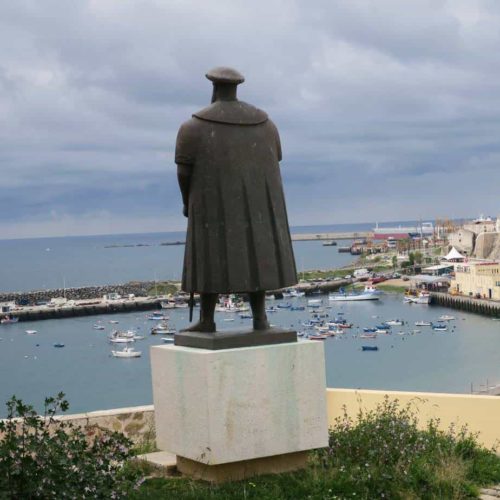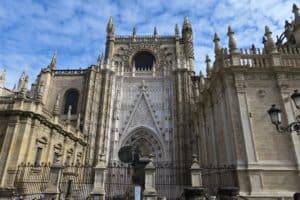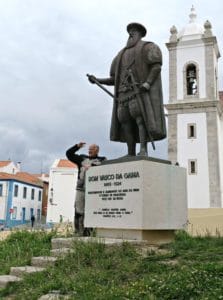Iberia is a mere 8 miles across the water from Morocco and yet as we ride across it and read about it, we find it’s another region with a long and surprising history – in this case from over 1.2 million years of inhabitation when Homus Erectus walked these lands. It is hard to think that Spain and Portugal from whence came the greatest European Explorers of the 15th and early 16th century – Henry the Navigator, Bartolomeu Dias, Vasco Da Gama, Christopher Columbus and Ferdinand Magellan – were, prior to their time and to being the citadel of Catholicism – an Islamic Caliphate formed by the Moors, a people of mixed Arab, Spanish and Berber origins.
And now, those of Moorish extraction cannot get entry back here for love nor money – it may be only 8 miles across the Med, but they’re most unwelcome here – oh well, it’s all about timing.
One of the themes of this criss-crossing the world by motorcycle that has been our obsession since 2001, has been to learn as much about and reflect on the efforts of those European explorers that dominated the first phase of the Age of Discovery. It is was from the Iberian Peninsula that they sailed, mapping out the Euro-centric view of the world’s limits and opportunities – and of course establishing the first iteration of European colonisation – as well as the first circumnavigation of the globe.
The limits of the history we were taught at school is often a topic of discussion in NZ, specifically with respect to our almost total ignorance of the New Zealand Wars and our country’s pre-European history. But as a book like “The Silk Roads” (2017, Peter Frankopan), emphasises the pre-European history of the whole world is one so rich that it can only benefit our understanding of the origins of other peoples – many of the descendants of which are displaced, or inhabit disputed lands to this day. The Persians, the Egyptians, The Scythians, The Hindu, The Moors, The Xiongnu and of course the Han Chinese – all inhabited that vast stretch of territory from the Mediterranean, Africa and on to the Far East, well before the Western European Empires evolved.
Anyway when we did our 2005 ride from Venice to Xanadu it was with Marco Polo’s book, “The Travels of Marco Polo” in hand and we tried as much as we could to follow his route east. I still marvel of the detail from that book that we were able to identify on that ride. And then in 2007 when we did our Backblocks America ride it began in the Bahamas where Christopher Columbus landed (in 1492) and discovered his New World instead of the East Indies that he was trying to reach, having learnt so much about that magical world of spices from Marco Polo’s 13th century efforts.
And while riding the Andes south in 2010 to the Straits of Magellan and then back up from Patagonia through the Amazon and back up to Columbus’ Caribbean, the far-reaching influence of the Spanish and Portuguese is inescapable as they divided up the world as per the 15th century’s Treaty of Tordesilles, and its longitudinal line just off the Iberian coast, to the west was Spain’s, to the east Portugal’s.
All this action well before any European reached the bush-clad isles of the South Pacific. da Gama was appointed Viceroy of India for example, some 250 years before the Brits installed their first Indian Supremo. Nor had I realised that he threatened to go across to the Spanish and join forces with Magellan unless he received more of the booty from his exploits across the Indian Ocean. The Italian, Christobal Colon had established that precedent of ‘performance pay’ by selling his services to the highest bidder – and look what Spain got from that investment – almost all of the Americas.
Seville’s cathedral contains the tomb of Columbus, so we made a point of stopping by to pay homage. The cathedral itself is massive and a major tourist attraction, with the long queues such attractions draw in Europe.
We spent some time in Sines, just south of Lisbon and da Gamas’ hometown. He was the town’s premier citizen and for that matter still is – his name is everywhere and there’s a cool statue of the man by the town’s castle, looking out to sea. Actually by all accounts he was a bastard as the story of the incident with the shipload of 400 Muslim pilgrims attests. He loaded them all, women and children, aboard and then watched through the portholes as his men set fire to the ship. Charming chap alright.
By contrast, Magellan’s birth town of Sabrosa in the north of Portugal is nowhere near the sea. However his early naval career saw him too serving time in India for the Portuguese. But he really wanted to pioneer the westward route to the East Indies that Columbus had failed to find and given sailing West from Iberia was the right of the Spanish, not the Portuguese, went and worked for them. The rest is history – he became the first person to sail around the world, albeit eastwards to the East Indies first and finally westwards to the same. The winds, once he rounded South America were so favourable he called in the peaceful or Pacific Ocean.
Portugal is such a run-of-the-mill European country nowadays, but its contribution to the Age of Discovery was without peer.




Comments are closed.